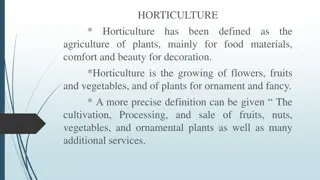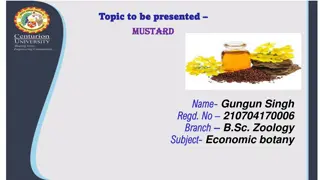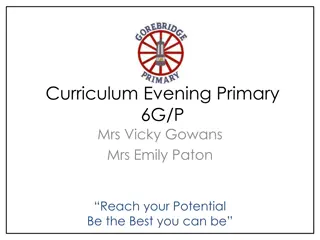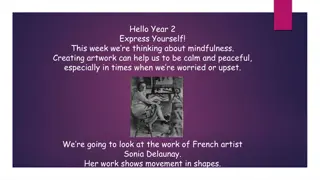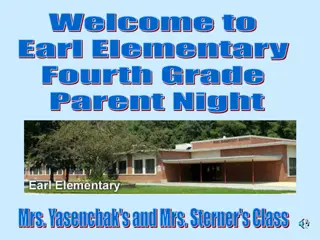Cultivation Practices of Acacia auriculiformis by Mrs. Sonia Panigrahi
Acacia auriculiformis, commonly known as Australian Wattle, is a tree species native to New Guinea and Australia. It is widely cultivated in India for its valuable attributes such as drought tolerance and soil conservation properties. The tree's cultivation practices, including nursery techniques and plantation methods, are detailed in this informative guide by Mrs. Sonia Panigrahi, an Assistant Professor in the Department of Agronomy and Agroforestry at CUTM, Paralakhemundi.
Download Presentation

Please find below an Image/Link to download the presentation.
The content on the website is provided AS IS for your information and personal use only. It may not be sold, licensed, or shared on other websites without obtaining consent from the author. Download presentation by click this link. If you encounter any issues during the download, it is possible that the publisher has removed the file from their server.
E N D
Presentation Transcript
Cultivation Practices of Acacia species Mrs. Sonia Panigrahi Assistant professor Department of Agronomy and Agroforestry. CUTM,Paralakhemundi
Acacias Scientific Name: Acacia auriculiformis. English Name: Australian Wattle Family: Fabaceae Common Name:Acacia,Sunajhari(Odia )
Distribution It is a native of New Guinea, North Australia and Queensland; and exoticin India. It has been successfully raised in West Bengal, Bihar and Andhra Pradesh for about forty years, and more recently in Kamataka, Orissa, Uttar Pradesh and Maharashtra. Physiognomy It is a moderate sized tree, attaining a height of 10m sometimes upto 15m. Bark is smooth, white or light grey, fissure occurs in later years. The leaf stalks are modified into flattened blade called as phyllode, which is narrow oblong slightly curved and sickle shaped, leathery, dull green.
Phenology SeedsripenduringJanuary-March;besttimeforcollectionofpodsis February- March,byloppingandspreadingoutfor5-9daystoopen. Seedsretainviabilityupto2 years.Germinationcapacityisabout50%. Silvicultural It is a strong light demander but regenerate under shade. It is a fire tender.Itis drought-tolerantbutsensitivetoseveredrought. It producesprofuse root suckers but is a poor coppicerunder Indian condition Climate It grows from sea-level to about 700 m altitude. It does well in temperatureof26- 30 Candcansurviveupto40 C. It is well adapted to drought and grow with as little as 600 mm rainfall. SilviculturalCharacters Characters Climateand andSoil Soil
Nursery Technique Seed requires pre-treatment, either 24-48 hours immersion in water at room temperature or in cooling boiled water, for 24 hours. May be sown in nursery beds in polythene bag containers during March to early April, under shade which is removed after germination is completed. Seed is sprinkled with kerosene oil to protect against ants. Germination starts in 15-20 days and is complete in 30-35 days. A thatch barrier on one side of the bed is given to protect against direct winds. Planting Four months old nursery seedlings are planted out with ball of earth, when 15-30 cm tall, at the break of monsoon in June - July; can be successfully raised by stump planting also. Planting is done in pits 30 cm3 to 45 cm3at a spacing of 1 m x 1m to 2m x 2m.
As a Plantation Tree A. Auriculoformis grows quickly, coppices readily and is a source of fixing nitrogen, improving soil leaves and pods are widely used as fodder. Leaves contain about 7-15% crude protein, 20.1-33.3% crude fibre, 1.2-2.6% calcium and 0.1-0.2% phosphorus. In dry areas it is heavily browsed by camel and goats. The tree provides shade and shelters and is an excellent soil binder, which makes it useful in soil conservation works. The species has been groun covering arid, semi-moist, irrigated farmlands, etc. Babul is basically a household tree and is the best friend of the farmers. It is grown around houses, wells, compounds, on farm lands and other available places in the private holdings. fertility and its under various conditions
Taungya plantation of Acacia Auriculoformis started in Berar area and the plantations raised in the past have been successful to a large extent. However, the system has been given up recently. It has been grown as taungya plantation successfully with a variety of agricultural crops. Babul is a common agroforestry tree species for large part of India, particularly for alluvial plains and Indian peninsular region. The species is specifically suitable for growing in arid and semi-arid climates. However, it avoids extreme arid conditions. .
In Rajasthan, A. Auriculoformis is a popular species in the northern and central regions. In these areas, two sub-species namely, indica and cupressiformis are common. A. Auriculoformis sub-species cuppressiformis is preferred on agricultural cropland because of its narrow crown In Indo-Gangetic plains, the species is equally popular in irrigated and un-irrigated agricultural lands. However, it has shown better results in comparison to other species in terms of productivity and economic returns in un-irrigated croplands and wastelands.
UTILIZATION Working and Finishing Properties It is an easy wood to convert and resaw when green, but it becomes harder and tougher when seasoned. It works well by hand machines and finishes to a good surface. Its working quality index based on quality of worked surface and ease of working is 84 compared to 100 for teak. Timber The wood is widely used for construction as posts, rafters, beams and in door frames. It is one of the most favoured timbers for all types of agricultural implements like ploughs, harrows, crushers and rice pounders, and is extensively used in card building, for yokes, shafts, wheels and body work. Babul wood is also recommended for certain types of sports and athletic goods like clubs, wall bars, parallel bars, etc.
Gum The gum obtained from A. Auriculoformis is known as Indian Gum Arabic . It is generally considered inferior to the true Gum Arabic obtained from A. senegal in medicinal properties. Medicinal Uses The leaves, bark, gum and pods of A. Auriculoformis are used for medicinal purposes. The tender growing tops and leaves are used as a douche in cases of gonorrhoea, dropsy and leucorrhea. Pulp of leaves, decoction of bark and the gum are prescribed in diarrhoea, dysentery and diabetes. A paste made of the burnt leaves with coconut oil makes a very efficacious ointment
Fuelwood As a fuelwood, it is an excellent material and is also made into charcoal. Its charcoal is considered to be superior to charcoal from other species. Pulp and Paper The wood from Acacias is good for paper and pulp making. It is reported that, rayon and paper pulp properties from A. Auriculoformis compare favourably with those of Dendrocalamus strictus and Eucalyptus hybrid. However, since babul wood is highly valued for agricultural implements and house construction it is rarely available for pulp making.
Tanning Material Bark: The bark is obtained mainly as a by-product when trees are felled for timber or beating the logs with wooden mallets and the strips obtained are dried in the open chipped into smaller pieces and sent to tanneries without grading. The proportion of bark to wood is roughly 1:5 by weight. A 15 year old plantation of about 620 trees per hectare may yield about 5 tonnes of bark per hectare. Pods: The whole pod of babul contains about 12-19 per cent tannin and that removed of tannin. fuel. It is separated by seeds 18-27 per cent
Food The seed of babul are eaten roasted or raw in time of acute scarcity in Rajasthan. Air dry seeds contain moisture 8.83%; crude protein 26.4%; eather extract 3.3% and free extract 62.9%; crude fibre 2.7%; total ash 4.7%. The other elements in seed are calcium 673.0; phosphorus, 420.0; iron 4.9; Niacin, 3.17; ascorbic acid 4.51; Thiamin 0.24, mg/100 gm. Dye Stuffs Dye stuffs from A. Auriculoformis is prepared by boiling the pods, leaves, bark in varying proportion and occasional additions of wood extract. Variety of colours from yellow, to black through brown can be obtained by varying proportion of leaves, pods bark and wood extract.
Fencing Material Thorny branches of babul are useful as fencing material. The spines are also used as fishing hooks and as a substitute for pin. The trees are also planted closely along the field boundary as live fence. Avenue Tree Babul is useful as a hardy avenue tree, where selection of species is difficult. It is also used as a live-hedge fence round circular trenches for planting other important avenue trees.
NATURAL REGENERATION Coppicing In some areas, particularly, in states of Andhra Pradesh, Karnataka, Tamil Nadu and in the districts of Guntur, Anantpur, Bellary, Chingleput and Doab, babul has been coppicing well. In these areas, coppice can be relied on as one of the means of regeneration. In India, in low rainfall areas, it does not coppice. When trees are young and small in size, coppicing vigour is more. The important factors which influence successful natural regeneration are: Moisture Sufficient moisture is necessary to soften the seed coat. This may take quite some time. Abundant moisture is observed in riverain tracts where abundant regeneration come up on fresh alluvial deposits. However, regeneration of young seedling is destroyed in flooded areas. Excessive moisture causes damping-off in seedlings. Seedlings are also damaged when buried under thick deposits of silt in riverain tracts.
Light Adequate light is an essential factor for the germination and establishment of seedlings. A Auriculoformis is a strong light demander. Seed germination is considerably retarded under dense shade. If the seed germinates under shade, the development of seedlings is not proper and they cannot establish. Fresh light is not a problem for babul because a patchy overhead shade makes plenty of light available. Soil A. Auriculoformis has a long tap root system. Loose and deep soils facilitate the development of the root system. Root of A. Auriculoformis easily takes up moisture from loose soil, the development of tap root is more rapid in deep soil. Adequate drainage and aeration in soil are the most important factors for establishment of seedlings. In the presence of aeration, seedlings are unable to establish. compact soil and insufficient Fire and grazing render the soil more compact, impervious and less fertile. Seeds do not germinate in heavily burnt or excessively grazed soil.
Nursery Practices Sowing and germination: The treated seeds are sown in nursery beds either by broadcast sowing or by dibbling method. However, the dibbling , method is preferred. A Auriculoformis is seldom raised in nursery beds. It is generally raised in polythene containers. Two or three treated seeds are sown in each bag, about 1.5 cm deep during February-March i.e. about 5 months before transplanting in the field. The soil mixture used in polythene bags consist of soil and compost in 2:1 ratio. Germination commences one to three weeks after sowing and is mostly completed in a months time. The germination of the seed is epigeal. The radicle emerges and descends.
Vegetative Propagation Vegetative propagation in A. Auriculoformis is successful under mist chamber conditions. Success is reported in case of rooting of stem cuttings treated with indole acetic acid and indole butyric acid. Tissue culture propagation of A. Auriculoformis has been successful with callus formation only. Irrigation in the Nursery Watering in the nursery is done frequently, till the seed germination terminates. After germination, 2-3 waterings a week are sufficient. Watering is one of the most important operation which decides the success of failures of seedlings in the plantation. Excessive watering results in production of pampered seedlings, which fail when planted out under difficult conditions. Therefore, watering in the nursery has to be planned most judiciously. The number of waterings and the quantity of water required per plant or per bed depends upon the locality and season.
Weeding Young seedlings have to be weeded regularly for 2-3 months. During weeding, excess seedlings are removed so as to leave only one seedling in each polypot. Shade In the early stage, shade is provided for the proper development of seedlings. It is reported that shade increases the germination percentage. Shade is required during winter when there is a danger of frost and during summer when the temperature is too high. Hardening of the Seedlings Hardening is a necessary process for seedlings developed in the nursery. Seedlings are kept in the nursery under constant care for some time while they develop. The good seedlings are selected and placed in separate beds, where they are given less water and exposed to the sun gradually to condition them for planting out.
Planting Practices Size and quality of planting stock Seedlings attain a height of 30 to 40 cm in a period of 6 months. Experience indicates that medium sized stock, between 30 to 40 cm tall with a woody root collar, has a better survival rate. The seedlings should be transplanted at this stage when the root shoot ratio is optimum. Further growth of shoots leads to imbalance in root shoot ratio and a large number of casualities of planting out. Mortality in plantation is high for undersized and weak seedlings. Grading of seedlings is, therefore, important. Direct sowing This is the easiest and most common method for raising babul plantation in the field. Several methods have given satisfactory result. The successful ones are by broadcast sowing (seed rate 2.5 3 kg/ha), dibbling in lines, patches or mound sowing during June (seed rate 1 kg/ha).
Root system A. Auriculoformis species has a very long tap root system. As the growth advances, several lateral roots also develop at the end of the first season and after some time the tap root and lateral roots cannot be easily distinguished. Seedlings of plantable size are graded in the nursery. The gradation depends to a large extent on local experience and the establishment of local standard. The main objectives of a grading system for planting stock are: To eliminate seedlings with damaged or diseased tops or roots. To eliminate seedlings below the minimum standard of size and root development.
Planting Babul is planted in man made forests under several environmental conditions using different methods of establishment. The seedlings are generally planted in pits having the size of 30x30x30 cm. The most common spacing adopted for plantation is 4m x 4m. On road sides, deeper pits of the size of 45 x 45 x 45 cm are preferred. Mound planting is practiced where there is fear of water logging specially on dug up road sides. For proper growth and survival it is necessary to give one or two waterings after planting. This is specifically required in arid regions. Irrigation after planting is not a prerequisite in areas having sufficient soil moisture and precipitation. Higher survival rate and better rate of growth is reported when soil and water conservation measures are also adopted
PEST AND DISEASES A. Auriculoformis is liable to be damaged by many groups of insect pests (Coleoptera, Lepidoptera, Hemiptera and Orthoptera) and diseases. Celosterna scabrator and Oxyrachis tarandus are reported to be the most notorious pests of A. Auriculoformis in various localities. The mango mealy bug Drosicha stebbingi, primary pests of Mangifera indica also attack A. Auriculoformis. Heavy infestation caused by the bug results in the death of shoots and twiges and deforms the growth of the saplings of A. Auriculoformis. Almost all the stages of the plant are affected by different fungal pathogens..
Among fungi members of Deuteromycetes are the most dominant group causing serious diseases of seeds. Various treatments are being used against the fungal infections present on or within the seed. Seed treatment with various fungicides, organomercury compounds, etc. are practiced for the effective control of seed-born and soilborn diseases. Different types of root diseases like root-rot, collar-rot, wilt; stem diseases like die-back, stem canker, heart rot; foliages diseases like leaf rust and leaf spot are caused by fungi like Ganoderma lucidum, Polyporus gilvus, Botry-odiploidia theobramae, Fusarium sp., Fomes badius, Ravenlia acaciae arabicae, Cylindrosporium acaciae
HARVESTING Babul forest are generally managed on a rotation of 30 to 40 years. Trees planted in agro- forestry plantations are generally harvested on shorter rotations. In forests, the trees are generally marked for felling during December-January and felling is carried out from February to April. The timber and firewood is sorted out and timber is generally transported to depots by April-May. Harvesting is completed by June before the onset of the monsoons.







